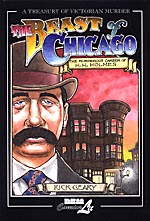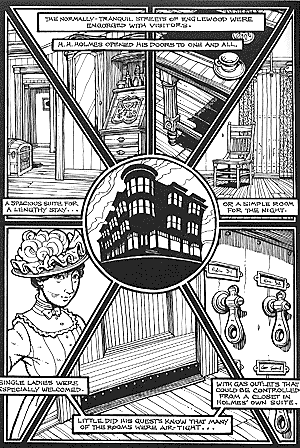 By Rick Geary
By Rick Geary
80 pages, black and white
Published by NBM
Many people assume that brutal or senseless murders did not really happen until the 20th century, but that’s hardly the case. All throughout history, people’s lives have been shattered by the ruthless killings of each other, both in public and in secret. Cartoonist Rick Geary has shown in his Treasury of Victorian Murder that modern conveniences are hardly necessary in order to kill—and his latest volume, The Beast of Chicago, shows just how crafty a killer in the 1890s could be…
H.H. Holmes was always an odd man. As a child (back when he was known as Herman Mudgett) he was obsessed with anatomy and surgery, and as he grew older he began his… experimentations. It wasn’t until he left his New England home (as well as his wife and child) and moved to Chicago that his obsession with death truly gained control over his life. Changing his name, Holmes soon constructed a three-story mansion of deathtraps just in time for the Chicago World’s Fair… but that would only be the beginning of Holmes’s bizarre life.
Geary’s Treasury of Victorian Murder series has never dealt with pleasant subjects (the title alone should give you a hint in that regards) but The Beast of Chicago is quite possibly the most unsettling to date. Maybe it’s how Geary carefully depicts Holmes’s descent into madness, as his actions shift from methodical to more and more erratic. Maybe it’s his careful description of what happened, with Geary’s “castle” where gas jets were hooked up to rooms, trap doors hid dissection labs, and numerous bodies were consigned to the acid and quicklime for destruction. Maybe it’s the narration style which casually mentions when people “went away”, with the implications on how Holmes quite possibly murdered his discarded objects of affection or threats to his business. Whatever the reason, Geary’s writing in The Beast of Chicago (with research meticulously backed up with bibliography) does an excellent job of telling the story of who was quite possibly the United States’s first serial killer.
 Geary’s art has always evoked a feeling of earlier times from me. I think part of it has to do with how Geary rarely uses solid blacks to shade in an area, instead going for thin parallel lines to fill in the space. With each little, carefully placed line, one gets the feeling that this is somehow an artifact of an earlier time when everything was handcrafted with care. Geary’s storytelling is just as careful and attractive as his individual panels; pages where images radiate out from a central circular anchor, for instance, do a great job of tying aspects of a greater whole together on a single page. Geary also uses circular panels to create what are almost like bubbles or zoom-ins within a single panel, pulling the reader’s eye onto the specific elements that Geary wants you to see. Geary has complete and utter control over the way the reader reads the pages of The Beast of Chicago. For a book about a controlling and methodical man, that’s both appropriate and creepy at the same time…
Geary’s art has always evoked a feeling of earlier times from me. I think part of it has to do with how Geary rarely uses solid blacks to shade in an area, instead going for thin parallel lines to fill in the space. With each little, carefully placed line, one gets the feeling that this is somehow an artifact of an earlier time when everything was handcrafted with care. Geary’s storytelling is just as careful and attractive as his individual panels; pages where images radiate out from a central circular anchor, for instance, do a great job of tying aspects of a greater whole together on a single page. Geary also uses circular panels to create what are almost like bubbles or zoom-ins within a single panel, pulling the reader’s eye onto the specific elements that Geary wants you to see. Geary has complete and utter control over the way the reader reads the pages of The Beast of Chicago. For a book about a controlling and methodical man, that’s both appropriate and creepy at the same time…
The Beast of Chicago is by far my favorite of Geary’s books to date; not only because it spotlights a man that very few people know about, but by how well he tells the story. By the time you’re done with The Beast of Chicago you’ll feel like you really understand just how the killings happened, and what a truly deranged mind Holmes had. For those who thought the Victorian era was a pure and saintly one, The Beast of Chicago should quite nicely set those thoughts to right.
Purchase Links:
